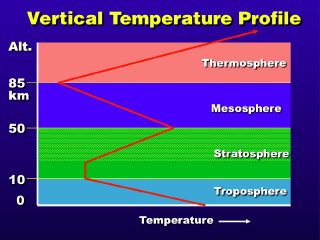 Atmospheric temperature varies non-uniformly due to the non-uniform heating
of the air by sunlight or by the ground. The upper stratosphere and thermosphere
are warm because they absorb various short wavelengths of sunlight; the rest
passes through the air to the ground, heats up the ground, then heats up the
lower troposphere. The upper troposphere is not heated by the sun or the ground,
so it will be cooler than the lower troposphere.
Atmospheric temperature varies non-uniformly due to the non-uniform heating
of the air by sunlight or by the ground. The upper stratosphere and thermosphere
are warm because they absorb various short wavelengths of sunlight; the rest
passes through the air to the ground, heats up the ground, then heats up the
lower troposphere. The upper troposphere is not heated by the sun or the ground,
so it will be cooler than the lower troposphere.
Given that there are no space colonies
above the ground, and no topographic features higher than about 10 km, humans
are limited to breathing the air in the troposphere. Thus, most air pollution
problems occur in the troposphere and not elsewhere, since contaminating the
other parts will not cause harm to things at the ground. The exceptions would
be the depletion of the stratospheric ozone layer and global climate change
due to accumulation of certain gases in the global atmosphere, since the harm
to humans would not come from breathing the pollutants; rather, the harm comes
from changes in the environment (more UV radiation, higher temperatures, etc.).



 Atmospheric temperature varies non-uniformly due to the non-uniform heating
of the air by sunlight or by the ground. The upper stratosphere and thermosphere
are warm because they absorb various short wavelengths of sunlight; the rest
passes through the air to the ground, heats up the ground, then heats up the
lower troposphere. The upper troposphere is not heated by the sun or the ground,
so it will be cooler than the lower troposphere.
Atmospheric temperature varies non-uniformly due to the non-uniform heating
of the air by sunlight or by the ground. The upper stratosphere and thermosphere
are warm because they absorb various short wavelengths of sunlight; the rest
passes through the air to the ground, heats up the ground, then heats up the
lower troposphere. The upper troposphere is not heated by the sun or the ground,
so it will be cooler than the lower troposphere.